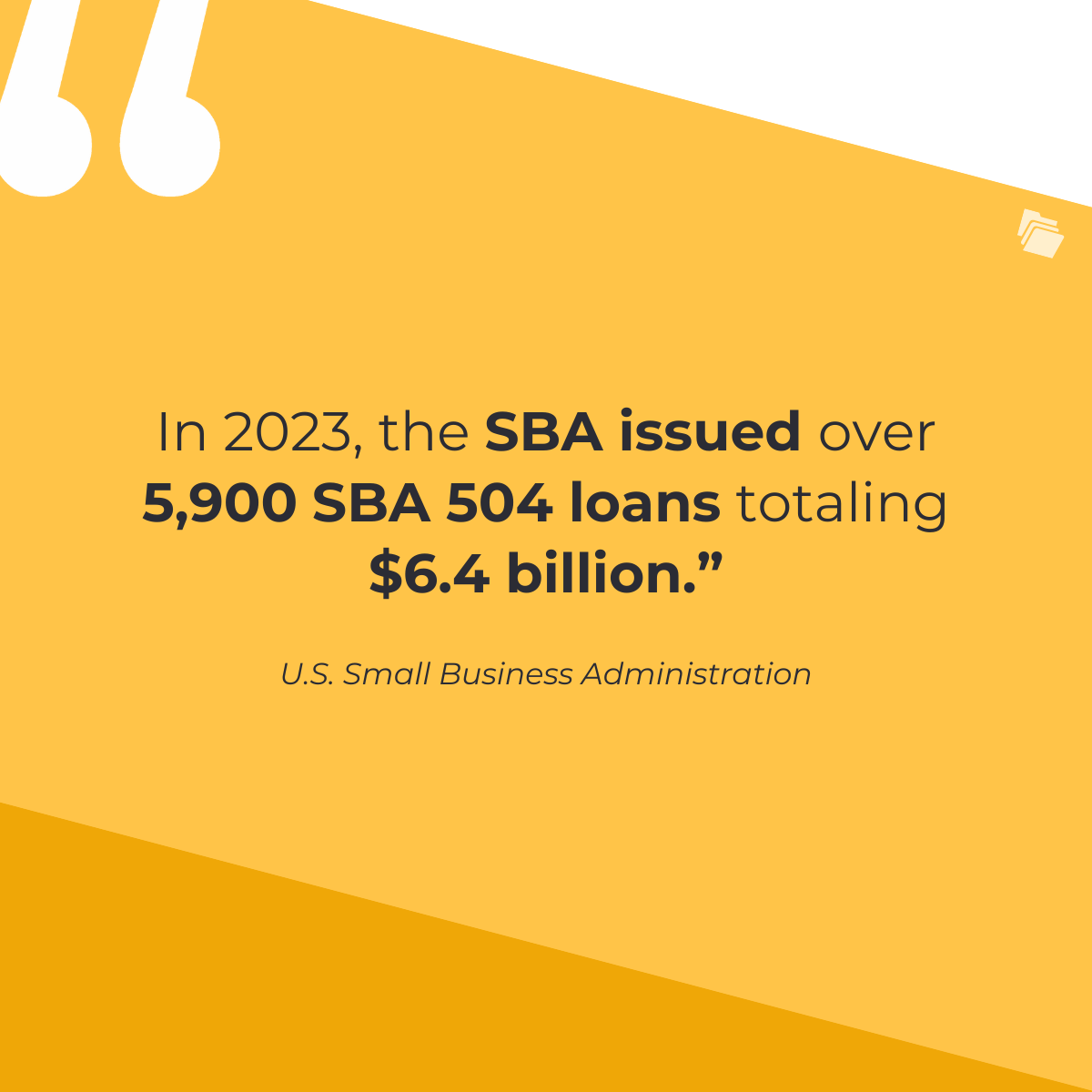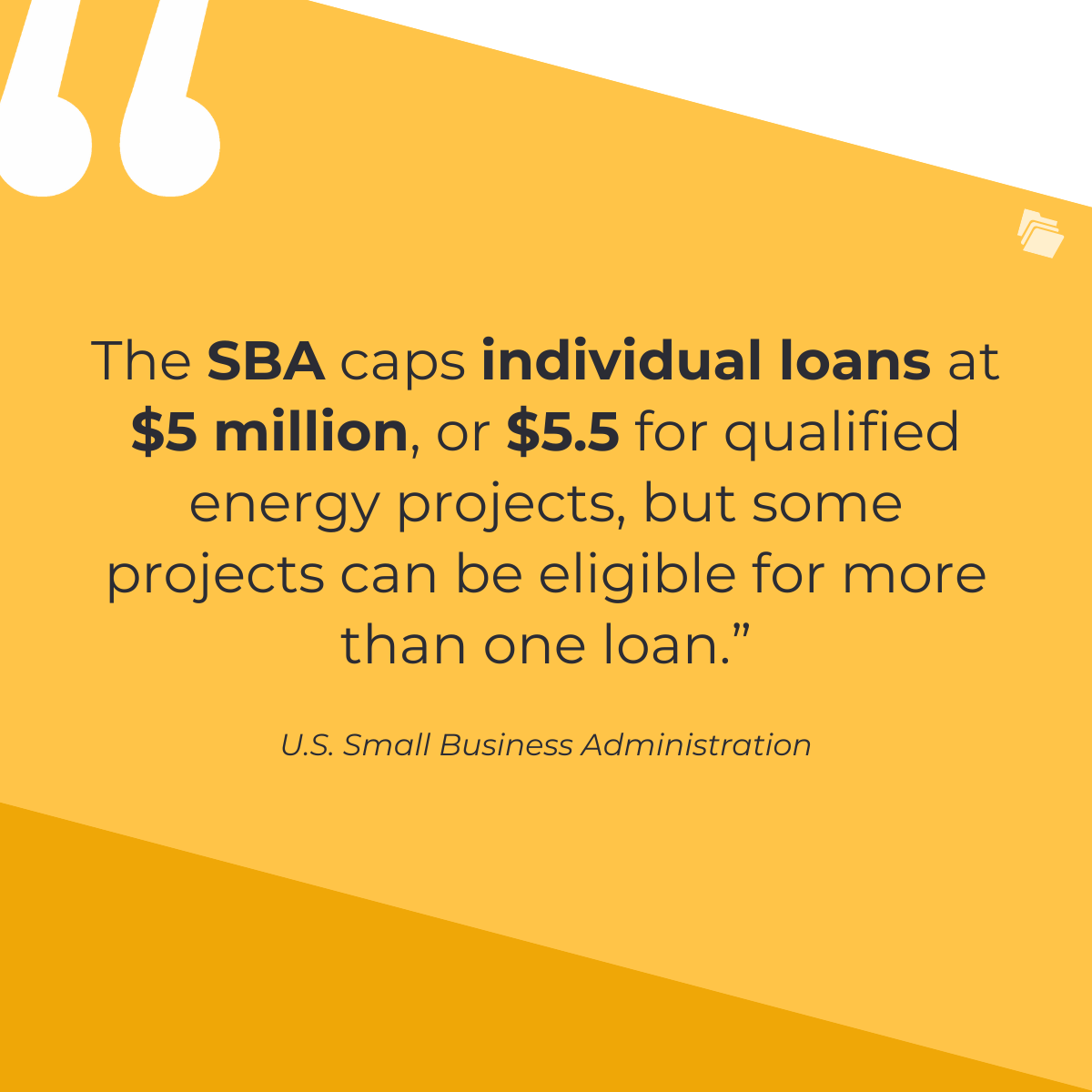An SBA 504 loan is a unique financial product that small businesses can use for major purchases like real estate and equipment. SBA 504 loans are unique in that they have three parties: a bank or credit union who contributes 50% of the capital, a certified development company (CDC) who contributes 40%, and the borrower who contributes the remaining 10% as a downpayment.
These loans are important for small businesses because they can be used to purchase or upgrade long-term fixed assets. Small businesses can use an SBA 504 loan for things like real estate for parking lots or buildings, equipment, furniture, and land, but not to simply invest in real estate or to purchase inventory.
The Small Business Administration (SBA) caps SBA 504 loans at $5 million each, but some projects can be eligible for more than one loan. In 2023, the SBA issued over 5,900 SBA 504 loans totaling $6.4 billion.

SBA 504 Loan Fundamentals
SBA 504 loans are guaranteed by the Small Business Administration, which works hand in hand with certified development companies (CDCs) to offer these unique loans to small businesses.
What Can I Use an SBA 504 Loan For?
Generally speaking, SBA 504 loans can only be used for expenditures that fit certain criteria:
- Long-Term. Projects like building a new parking lot or purchasing a new piece of major machinery may qualify for an SBA 504 loan, but short-term expenses like inventory and marketing generally do not qualify.
- Fixed. Fixed assets are generally long-term assets (so far, so good) that are tangible and generate income for the business. More colloquially, fixed assets are permanent, physical objects the company uses during day-to-day business, like a piece of manufacturing equipment or a warehouse.
- Assets. While small businesses occasionally seek out loans for things like payroll or rent, those are expenses, not assets. In other words: SBA 504 loans are generally intended to be an investment into a long-term tangible object, not to simply cover an expense.
Who is Eligible for an SBA 504 Loan?
To qualify for an SBA 504 loan, businesses must meet seven criteria:
- Be an operating business. The Small Business Administration guarantees these loans for investing in an operational business.
- Operate for profit. Non-profit organizations are not eligible for SBA 504 loans.
- Be located in the U.S. The SBA is a U.S. government program so businesses operating in other countries are ineligible.
- Meet SBA business size requirements. In Part 121 of Title 13 of the Code of Federal Regulations, the SBA sets guidelines for what they consider a “small business” designation. These requirements include having a net worth of less than $15 million and earning less than $5 million in average net annual income.
- Not be an ineligible business type. Certain exceptions, like casinos and multi-level marketing companies, are not eligible for SBA 504 loans.
- Not be able to obtain credit from other sources. In other words, the SBA only offers SBA 504 loans to businesses that can’t obtain comparable terms from another institution.
- Be creditworthy and demonstrate a reasonable ability to repay the loan. Businesses must be able to repay the loan to qualify.
SBA 504 Loan Parties
Most traditional loans are between two parties: a lender and a borrower. SBA 504 loans are unique because they introduce a third party: a certified development company, or CDC. Here is the role each party plays:
- Participating Lenders. These are third-party lenders (typically a bank or a credit union) that agree to participate in SBA 504 loans. They generally supply 50% of the capital for the loan, but since the CDC and the borrower supply the other 50%, their risk is somewhat lower than in a traditional loan.
- CDCs. CDCs typically bring 40% of the capital to the table. These certified development companies cooperate with the SBA, which guarantees their contribution to the loan. The percentages each entity contributes can be negotiated in the terms of the loan.
- Borrowers. The borrowers are the small businesses that receive the loan and use it for long-term fixed-asset improvements. They generally put 10% down.
- The SBA. The SBA isn’t a party to the loan, but they are involved. Since they guarantee the CDC’s portion of the loan (no matter how large it is—it can be more than 40%) and create the regulation SBA 504 loans are conducted under, they are guarantors as well as overseers of the loan.
SBA 504 Loan Structure and Terms
While the SBA sets some terms of SBA 504 loans, others are negotiable between the bank or credit union, CDC, and borrower.
- Interest Rates. Rates vary based on the prevailing market rate, so while there is not a set interest rate for SBA 504 loans, parties typically do not negotiate interest rates either.
- Loan Amount. The SBA caps individual loans at $5 million, or $5.5 for qualified energy projects, but some projects can be eligible for more than one loan.
- Loan Term. SBA 504 loans are available at 10-, 20-, and 25-year maturity terms, but specifics like early repayment penalties can be negotiated between the borrower, CDC, and financial institution.

Benefits and Drawbacks of SBA 504 Loans
For borrowers, the primary benefit of an SBA 504 loan is it allows them to purchase or improve a long-term asset. They receive the favorable rates set by the SBA, and the terms of SBA 504 loans are, by definition, more favorable than the terms they can secure from other institutions.
For lenders, SBA 504 loans are desirable because they represent less risk than a traditional commercial loan. After all, a large percentage of the capital is provided by the SBA via the CDC.
One drawback of an SBA 504 loan is that it can be time-consuming to secure. SBA loans require a large amount of documentation, but FileInvite helps make that process easy.
How to Apply for an SBA 504 Loan
Here’s the basic process for applying for an SBA 504 loan:
Step 1: Gather Documentation
To underwrite your SBA loan, the bank, or credit union, and the CDC will need extensive documentation, including personal and business tax returns for the previous three years, personal and business financial statements, a business debt schedule, and other documents relating to the specifics of your loan.
Step 2: Find a CDC
Unlike traditional loans, SBA 504 loans require the involvement of a certified development company or CDC. Find a qualified CDC to take the next step in preparing your application. Once you’re connected with a CDC, they can guide you through the rest of the application process. The SBA recognizes over 200 CDCs throughout the United States and its territories.
Step 3: Submit an Application
Your CDC will help you fill out the appropriate forms and paperwork to submit your final SBA 504 loan application. In addition to the documents you gathered in step one, your application should also include a description of the project and how the funds will be used.
Applying for an SBA 504 loan involves filling out a lot of paperwork and managing a large number of documents. FileInvite makes this process up to 6x faster with our leading document collection software.
FileInvite Can Help
FileInvite's secure file sharing and document collection platform can substantially streamline the SBA 504 loan application and approval process for lenders. By automating the document collection process, FileInvite reduces the administrative workload involved in manually collecting, tracking, and storing documents. It enables lenders to send automated requests for documents and receive real-time updates when documents are submitted by applicants, ensuring no delays in the application process.
To learn more and request a demo, visit FileInvite today.

Related Posts: